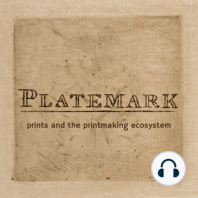60 min listen
s2e8 History of Prints The Italians (Pollaiuolo)
FromPlatemark
ratings:
Length:
66 minutes
Released:
Dec 7, 2021
Format:
Podcast episode
Description
In s2e8, co-hosts Ann Shafer and Tru Ludwig talk about the early history of prints and books in Italy, comparing it to Northern Europe. Differences in style and materials are discussed using the example of Masaccio's The Holy Trinity with the Virgin and St. John and donors, 1425–27, the fresco painting in chapel in Santa Maria Novella, Florence, Italy, and the Ghent Altarpiece, Jan and Hubert van Eyck's Adoration of the Mystic Lamb, 1432, an oil and tempera on wood multi-paneled altarpiece in St. Bavo’s Cathedral, Ghent, Belgium. Circling back to prints, we also talk a lot about Antonio Pollaiuolo's engraving, the landmark Battle of the Ten Nude Men, c. 1490. Of course, Dürer pops back up, too. Master E.S. (German, active c. 1450–1467). St. Matthias, c. 1450–60. Engraving. Sheet (trimmed within platemark): 149 × 89 mm. (5 7/8 × 3 1/2 in.). Baltimore Museum of Art, Baltimore. Master of the E-Series Tarocchi (Italian, active c. 1465). Polyhymnia, c. 1465. Engraving with hand coloring. Sheet: 185 × 105 mm. (7 5/16 × 4 1/8 in.); plate: 180 × 99 mm. (7 1/16 × 3 7/8 in.). Baltimore Museum of Art, Baltimore. Antonio Pollaiuolo (Italian, c. 1432–1498). Hercules and Antaeus, c. 1475–80. Bronze. Museum Nazionale del Bargello, Florence, Italy. Hubert van Eyck (Netherlandish, 1370–1426) and Jan van Eyck (Netherlandish, 1390–1441). Adoration of the Mystic Lamb or The Ghent Altarpiece, 1432. Oil and tempera on wood. 138 x 181 in. St. Bavo’s Cathedral, Ghent, Belgium. Masaccio (Italian, 1401–1428). The Holy Trinity with the Virgin and St. John and donors, 1425–27. Fresco painting in chapel. 236 x 125 in. in Santa Maria Novella, Florence, Italy. Antonio Pollaiuolo (Italian, c. 1432–1498). Battle of the Ten Nude Men, c. 1490. Engraving. Sheet (trimmed within platemark): 384 x 589 mm. (15 1/8 x 23 3/16 in.). Metropolitan Museum of Art, New York. Johannes de Ketham (German, 15th century). Fasciculus Medicinae, 1491. Bound volume published in Venice. Francesco Colonna (Italian, 1433/34–1527). Hypnerotomachia Polyphili, 1499. Bound volume published in Venice. Lucas Cranach the Elder (Germany, 1472–1553). Saint Christopher, c. 1509. Chiaroscuro woodcut printed in black and red-brown. Image: 11 x 7 1/2 in. (279 x 191 mm.). Minneapolis Institute of Arts, Minneapolis. Ugo da Carpi (Italian, c. 1470–1532), after Titian (Italian, 1489/90–1576). St Jerome in the desert seated facing left, c.1516. Chiaroscuro woodcut with two color blocks in green. Sheet: 156 x 95 mm. British Museum, London. Ugo da Carpi (Italian, c. 1470–1532), after Parmigianino (Italian, 1503–1540). Diogenes, c. 1527–30. Chiaroscuro woodcut printed from four blocks in gray-green. Image: 18 11/16 x 13 5/8 in. (475 x 346 mm.). Metropolitan Museum of Art, New York.
Released:
Dec 7, 2021
Format:
Podcast episode
Titles in the series (100)
s1e2 Role of the Curator: What all is entailed? A lot by Platemark
